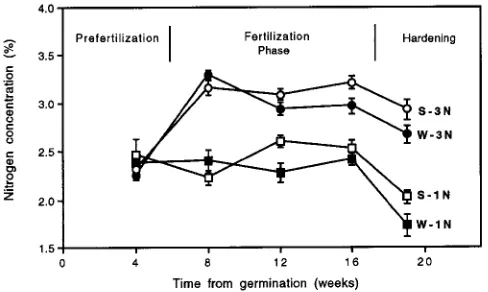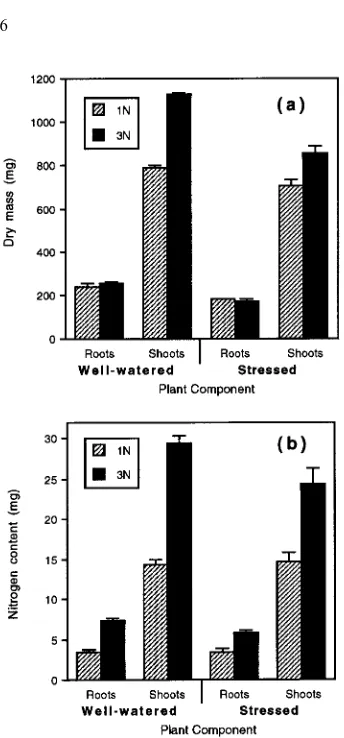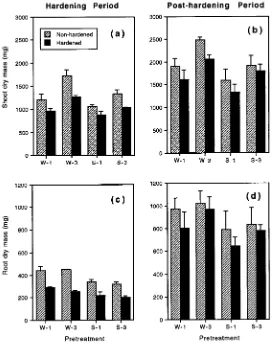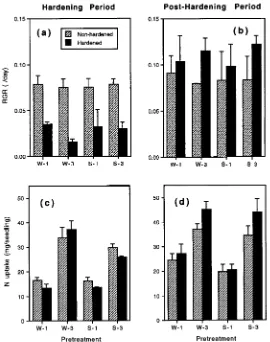Steady-state nutrition of Pinus resinosa seedlings: response to
nutrient loading, irrigation and hardening regimes
B. D. MILLER and V. R. TIMMER
Faculty of Forestry, University of Toronto, 33 Willcocks Street, Toronto, Ontario M5S 3B3, Canada
Received January 13, 1994
Summary
To test effects of fertilization on late-season growth and nutrient content of container-grown red pine (Pinus resinosa Ait.), seedlings were subjected to a factorial combination of two fertilization regimes (exponentially increasing concentrations providing 25 (1N) and 75 (3N) mg N seedling−1, respectively) and two irrigation regimes (well-watered and water-stressed) followed by drought-hardening or nonhar-dening. The fertilization treatments gave rise to steady-state nutrition in the seedlings during the prehardening phase. The 3N treatment increased macronutrient uptake significantly more than dry matter production, particularly in the roots, giving rise to what has been called luxury consumption of nutrients, or nutrient loading. Nutrient loading was higher in well-watered seedlings than in water-stressed seedlings. Among well-watered seedlings, relative growth rate of nutrient-loaded seedlings was more sensitive to drought during the hardening phase than that of nonloaded seedlings. However, when watering was resumed at the end of the hardening treatment, the relative growth rate of the nutrient-loaded seedlings (421%) exceeded that of the nonnutrient-loaded seedlings (213%). Nitrogen accumulation was also higher in nutrient-loaded seedlings than in nonloaded seedlings during the post-hardening phase.
Keywords: exponential fertilization, nitrogen accumulation, red pine, relative growth rate.
Introduction
Exponentially increasing fertilizer addition during nursery culture may enhance early growth of seedlings transplanted to forest sites. The cultural technique matches nutrient addition with plant requirements during exponential growth, and thus more closely simulates the field environment than conventional cultural techniques (Ingestad and Lund 1986). Red pine (Pinus resinosa Ait.), an important commer-cially produced species of container stock, responds more favorably to exponential fertilizer addition than to conventional, constant-addition-rate fertilization (Timmer and Armstrong 1987a, 1989). Exponentially increasing fertilization regimes induce steady-state nutrient conditions in plants by maintaining relatively stable internal nutrient concentrations throughout growth (Ingestad and Lund 1986), and improve the performance of seedlings transplanted to forest sites (Timmer et al. 1991). The benefit of exponential fertilization seems to increase with the harshness of the planting site (Timmer et al. 1991).
High-dose fertilization during nursery culture to build nutrient reserves before field planting may also promote early plantation performance. The practice, termed nutrient loading, increases internal nutrient concentrations without changing total dry mass, giving rise to what has been referred to as luxury consumption (Timmer
and Munson 1991). The nutrient-loaded seedlings exhibit greater growth and in-creased nutrient content after planting compared to conventionally fertilized seed-lings. Nutrient loading must be done with care, however, to avoid nutrient toxicity. Exponentially rising fertilizer addition reduces this risk by gradually exposing plants to high nutrient additions.
Generally, container-grown seedlings are prepared for planting by exposure to drought and nutrient stress by withholding irrigation and fertilization at the end of the growing season, a practice that reduces growth but increases hardiness (Blake et al. 1979, Landis et al. 1989). Exponential fertilizer addition combined with nutrient loading may confer hardiness without concomitant growth reductions. The intention of this study was to assess differential water stress and nutrient loading on the performance of red pine seedlings during the hardening and post-hardening phases in greenhouse culture.
Materials and methods
The seedlings were grown in trays containing eight Spencer-Lemaire Rootrainers each with five cavities 2.5 × 2.9 cm wide, 10.8 cm high and 75 cm3 in volume. Twenty-four trays of containers were uniformly filled with an equal weight of screened moist sphagnum peat moss, and tapped lightly on the bench to settle their contents. The cavities were slowly saturated from below and allowed to drain freely for 24 h. During this period, the containers were covered with a plastic sheet to prevent evaporative water loss. The cycle was repeated three times, after which the trays were considered to have reached container capacity (Timmer and Armstrong 1989). The saturated weight served as the reference value for the irrigation treatments during the 12-week period of fertilization (Weeks 4--16). The irrigation regimes were controlled by watering trays to container capacity after drying to either 90 or 55% of the container saturation weight (well-watered and water-stressed treatments, respec-tively). The trays were weighed daily, and water or nutrient solution added as necessary.
Red pine was selected as the test species because of its relative genetic uniformity (Fowler and Morris 1977) and determinate growth habit (Clements 1970). Two stratified red pine seeds were sown in each container cavity and covered with a thin layer of coarse silica grit. All trays were kept well watered for 4 weeks, when germinants were thinned to a single seedling per container. Thereafter, the fertiliza-tion and irrigafertiliza-tion treatments were started.
fertilization period, the lower amount being considered sufficient in nursery practice (Timmer and Armstrong 1989, Timmer and Miller 1991). Fertilizers were added in liquid form once per week to allow for the required dry-down between applications. Calculations for weekly additions of N were based on an exponential function (Ingestad and Lund 1986):
NT= NS(ert− 1),
where r is the relative addition rate (5.74% day−1 for the 1N treatment and 7.65% day−1 for the 3N treatment) required to increase NS, the initial level of nitrogen in the seedling (0.44 mg), to a final level NT + NS, where NT is the desired amount to be added over t, the number of fertilizer applications. To ensure attainment of steady-state plant nutrient status, initial nutrient additions were raised slightly at the expense of the final application to compensate for incomplete root exploitation of the sub-strate early in the rotation. A foliar rinse with water was used to bring the trays to container capacity. The seedlings were grown on raised benches in a heated and ventilated greenhouse (20--30 °C, 18-h extended photoperiod by high intensity lighting, 90 µmol m−2 s−1 at plant level) during the summer.
At the end of the fertilizer treatment period (Weeks 4--16), seedlings were kept well watered for the next 3 weeks to insure bud set. Hardening treatments were imposed at the beginning of Week 19 by adjusting irrigation so as to maintain water content between 50 and 55% of container capacity for 6 weeks. Seedlings in the nonharden-ing treatment were well watered durnonharden-ing this time. All trees were well watered durnonharden-ing the 6-week post-hardening recovery period. Trees were harvested at Weeks 8, 12, 16, 19, 25 and 31. Roots were carefully separated and washed with distilled water. Growth measures were conducted on individual seedlings and averaged by experi-mental unit. Trees were separated at the root collar and both shoots and roots were oven dried (68 °C for 24 h) for dry matter determination and subsequent grinding for nutrient analysis. Plant components from each unit were composited and analyzed by the methods described in Timmer and Armstrong (1987b). Nutrient status of the peat growing medium was assessed by determining the electrical conductivity of a saturated aqueous extract (Timmer and Parton 1984).
The trial was a full factorial experiment arranged in a randomized complete block design, testing two fertilizer, two irrigation and two hardening treatments. Treat-ments were replicated three times; the experimental unit was ten sample trees. Analysis of variance was applied to growth and nutrient composition data sampled at scheduled intervals. Main effects and interactions of treatments were tested by the Fully Factorial (M)ANOVA model and means were separated by the Tukey-Kramer HSD test included in SYSTAT (Wilkinson 1989).
Results and discussion
Initial loading and irrigation responses
The trees attained relatively stable N status in both exponential nutrient addition regimes (2.25--2.60% and 2.95--3.30% for the 1N and 3N rates, respectively) during the fertilization period (Figure 1), indicating steady-state achievement (Timmer et al. 1991). Conventional fertilization usually results in declining nutrient concentrations in seedlings because of growth dilution with time (Timmer 1991). The 3N regime raised shoot N concentration about one-third, confirming the effectiveness of the exponential nutrient loading technique. Nitrogen concentrations dropped sharply when fertilization ceased and the hardening treatments were imposed (Figure 1); seedlings in the 3N treatment were somewhat less affected than seedlings in the 1N treatment.
By Week 19, both dry matter production and nutrient uptake were greater in the 3N treatement than in the 1N nutrient treatment (Table 1 and Figure 2), although nutrient uptake was stimulated more than growth. In well-watered seedlings, total plant biomass was increased by 34%, whereas N uptake was increased by 107% (Figure 2a). In water-stressed seedlings, the 3N treatment increased total plant
biomass by only 16% and N uptake by 67%, relative to that in the 1N treatment. Significant positive interactions (P = 0.06) for N and K content between fertilization and irrigation treatments indicated that nutrient loading was more effective when the seedlings were well watered. Fertilization treatment had little effect on root growth, but N uptake (content) was markedly increased in the 3N regime relative to the 1N regime (66% in the water-stressed regime and 113% in the well-watered regime), indicating luxury consumption and buildup of N reserves in the roots (Figure 2b). Compared with seedlings in the 1N treatment, seedlings in the 3N treatment allocated proportionally less growth to roots than to shoots (Table 2).
Nutrient loading was accomplished with a mixed fertilizer solution. Vector nomo-grams (Figure 3) of relative biomass and nutrient responses to both irrigation and fertilization treatments in shoot and roots showed that loading stimulated N uptake
most, followed by P and then K. Calcium and Mg concentrations did not increase significantly and were diluted (Shift A, see Timmer 1991) in the shoots, probably because of the increased growth response. The uptake pattern of nutrients seemed to reflect the higher proportion of N and lack of Ca and Mg in the fertilizer solution. The vector nomogram also confirmed luxury consumption of N and P in the roots as a result of loading, as shown by simultaneous increases in concentration and content of these nutrients without a concomitant increase in dry mass (Shift D vectors). Improved nutrient uptake in the high nutrient regime when seedlings were well watered was indicated by higher N uptake in both shoots and roots (about 115% compared to 65% in the water-stressed seedlings, see Figure 3).
The irrigation regimes affected plant dry matter production and nutrient uptake significantly (Figure 2). Compared to water-stressed plants, well-watered plants had 16% more dry mass in the 1N regime and 34% more in the 3N regime. Nitrogen uptake, however, was not as sensitive to irrigation effects (Figure 2b): accumulation was unchaged in the 1N treatment, and only 22% higher for well-watered seedlings in the 3N treatment. Because growth increases from irrigation (Figure 2a) occurred without significant changes in N concentration (Table 2), the response reflects limitation of water rather nutrients. This pattern of nutrient uptake confirms results of previous irrigation experiments with container-grown red pine (Timmer and Armstrong 1989) suggesting that nutrient loading is best carried out under well-wa-tered conditions.
Table 2. Prehardening dry mass accumulation and nutrient concentration (% oven dry weight) of red pine seedlings reared under two irrigation regimes (well-watered and water-stressed) and two exponentially increasing fertilization regimes (1N and 3N).
Treatment Dry mass (mg) N (%) P (%) K (%)
Plant
Well-watered 1N 1029 b1 1.73 a 0.22 a 0.51 a
Well-watered 3N 1382 c 2.66 b 0.26 ab 0.54 a
Water-stressed 1N 889 a 2.03 a 0.24 a 0.53 a
Water-stressed 3N 1028 b 2.93 b 0.29 b 0.58 a
Shoot
Well-watered 1N 792 ab 1.81 a 0.21 a 0.47 a
Well-watered 3N 1128 c 2.61 b 0.23 ab 0.54 ab
Water-stressed 1N 707 a 2.06 a 0.21 a 0.51 a
1 Column values (within same plant component) not followed by the same letter are significantly
Response to hardening
The hardening treatment, consisting of 6 weeks of unrelieved water stress, reduced both root and shoot growth in all treatments. The effect was slightly greater in the 3N treatment than in the 1N treatment (Figures 4a and 4c).
The hardening treatment reduced the relative growth of the trees to less than half of that in the corresponding nonhardened trees (Figure 5a). Although earlier irriga-tion and fertilizairriga-tion regimes had little effect on the relative growth rates of the nonhardened seedlings, nutrient loading significantly reduced growth rates of hard-ened seedlings that had previously been well watered. Conceivably, in this case, water supply was depleted faster by the larger shoots associated with the 3N-treated
plants compared to those of the 1N-treated plants (Figures 2a and 4a).
Post-hardening response
After the hardening period, the relative growth rates of nonhardened seedlings remained unchanged, whereas the relative growth rates of hardened seedlings in-creased sharply (cf. Figure 5a and 5b). The increase in the relative growth rates of the hardened seedlings was greater for 3N-treated seedlings (421%) than for 1N-treated seedlings (213% greater) demonstrating the potential advantage of nutrient loading as a technique for conditioning stock for forest planting. Although 3N-treated seedlings showed a greater decline in dry matter production than 1N-treated seed-lings in response to drought stress, they grew faster when water subsequently became
available (Figure 5b). Similar results were observed with 8-month-old Pinus taeda L., where growth of seedlings with 2.0% foliar N recovered faster from drought than those with 1.3% foliar N (Pharis and Kramer 1964). Apparently, loaded seedlings drew on their greater nutrient reserves for this growth response.
By the end of the post-hardening period, the 3N-treated seedlings were similar in size to the 1N-treated seedlings (Figures 4b and 4d), but contained about twice the amount of N (Figures 5c and 5d), thus exhibiting continued accumulation of N reserves despite the cessation of fertilization 15 weeks earlier. Presumably, the extra N was derived from nutrients that accumulated in the growing medium during the fertilization period. This conclusion is supported by electrical conductivity (EC) measures of saturated aqueous extracts of the growing media, which at the end of
fertilization ranged from 0.59--0.79 mS cm−1 in the 1N treatment to 2.02--2.09 mS cm−1 in the 3N treatment. After hardening, EC readings in the 1N treatment dropped to 0.26--0.33 mS cm−1 compared to 0.38--0.44 mS cm−1 in the 3N treatment.
The residual nutrient accumulation was also more pronounced in hardened trees than in nonhardened trees, demonstrating an additional benefit of the loading treat-ment. Prehardening irrigation regimes, however, had no marked effects on final plant N status (Figure 5d). These enhanced nutrient reserves, particularly in roots (van den Driessche 1985, 1991), may be available for translocation and utilization in new growth (van den Driessche 1980, Margolis and Waring 1986, Timmer and Munson 1991).
Conclusion
We conclude that high rates of fertilization, inducing steady-state luxury consump-tion of nutrients in container-grown red pine seedlings, improve biomass accumula-tion and nutrient uptake even after exposure to a prolonged drought-hardening treatment. Growth comparisons and chemical analyses of seedlings that were nutri-ent loaded under differing irrigation regimes in the greenhouse and subsequnutri-ently hardened by drought stress showed that exponentially increasing nutrient regimes were effective in building seedling nutrient reserves, especially in well-watered seedlings. Although well-watered, nutrient-loaded plants were more susceptible to growth rate decline during the drought-hardening treatment, they exceeded the growth performance of nonhardened seedlings during the recovery period following the hardening treatment. Nitrogen uptake was also increased after hardening of the nutrient-loaded trees, and this is expected to improve performance after transplanting to the forest.
References
Blake, J., J. Zaerr and S. Hee. 1979. Controlled moisture stress to improve cold hardiness and morphol-ogy of Douglas-fir seedlings. For. Sci. 25:576--582.
Clements, J.R. 1970. Shoot responses of young red pine to watering applied over two seasons. Can. J. Bot. 48:75--80.
Fowler, D.P. and R.W. Morris. 1977. Genetic diversity in red pine: evidence for low genetic heterozygos-ity. Can. J. For. Res. 7:343--347.
Ingestad, T. and A.-B. Lund. 1986. Theory and techniques for steady-state mineral nutrition and growth of plants. Scand. J. For. Res. 1:439--453.
Landis, T.D., R.W. Tinus, S.E. McDonald and J.P. Barnett. 1989. Seedling nutrition and irrigation. Vol. 4. The container tree nursery manual. Agric. Handbook 674. US Dept. Agric. For. Serv., Washington, D.C., 119 p.
Margolis, H.A. and R.H. Waring. 1986. Carbon and nitrogen allocation patterns of Douglas-fir seedlings fertilized with nitrogen in autumn. II. Field performance. Can. J. For. Res. 16:903--909.
Pharis, R.P. and P.J. Kramer. 1964. The effect of nitrogen and drought on loblolly pine seedlings. For. Sci. 10:143--150.
Timmer, V.R. 1991. Interpretation of seedling analysis and visual symptoms. In Mineral Nutrition of Conifer Seedlings. Ed. R. van den Driessche. CRC Press Inc., New York, NY, pp 113--134.
Timmer, V.R. and G. Armstrong. 1987b. Diagnosing nutritional status of containerized tree seedlings: comparative plant analyses. Soil Sci. Soc. Am. J. 51:1082--1086.
Timmer, V.R. and G. Armstrong. 1989. Growth and nutrition of containerized Pinus resinosa seedlings at varying moisture regimes. New For. 3:171--180.
Timmer, V.R. and B.D. Miller. 1991. Effects of contrasting fertilization and moisture regimes on biomass nutrients, and water relations of container grown red pine seedlings. New For. 5:335--348.
Timmer, V.R. and A.D. Munson. 1991. Site-specific growth and nutrient uptake of planted Picea mariana in the Ontario Clay Belt. IV. Nitrogen loading response. Can. J. For. Res. 21:1058--1065.
Timmer, V.R. and W.J. Parton. 1984. Optimum nutrient levels in a container growing medium determined by a saturated aqueous extract. Commun. Soil Sci. Plant Anal. 15:607--618.
Timmer, V.R., G. Armstrong and B.D. Miller. 1991. Steady-state nutrient preconditioning and early out planting performance of containerized black spruce seedlings. Can. J. For. Res. 21:585--594. van den Driessche, R. 1980. Effects of nitrogen and phosphorus fertilization on Douglas-fir nursery
growth and survival after outplanting. Can. J. For. Res. 10:65--70.
van den Driessche, R. 1984. Nutrient storage, retranslocation and relationship of stress to nutrition. In Nutrition of Plantation Forests. Eds. G.D. Bowen and E.K.S. Nambiar. Academic Press, New York, NY, 516 p.
van den Driessche, R. 1985. Late-season fertilization, mineral nutrient reserves, and retranslocation in planted Douglas-fir (Pseudotsuga menziesii (Mirb.) Franco) seedlings. For. Sci. 31:483--496. van den Driessche, R. 1991. Mineral nutrition of conifer seedlings. CRC Press Inc., Boca Raton, FL,
274 p.





